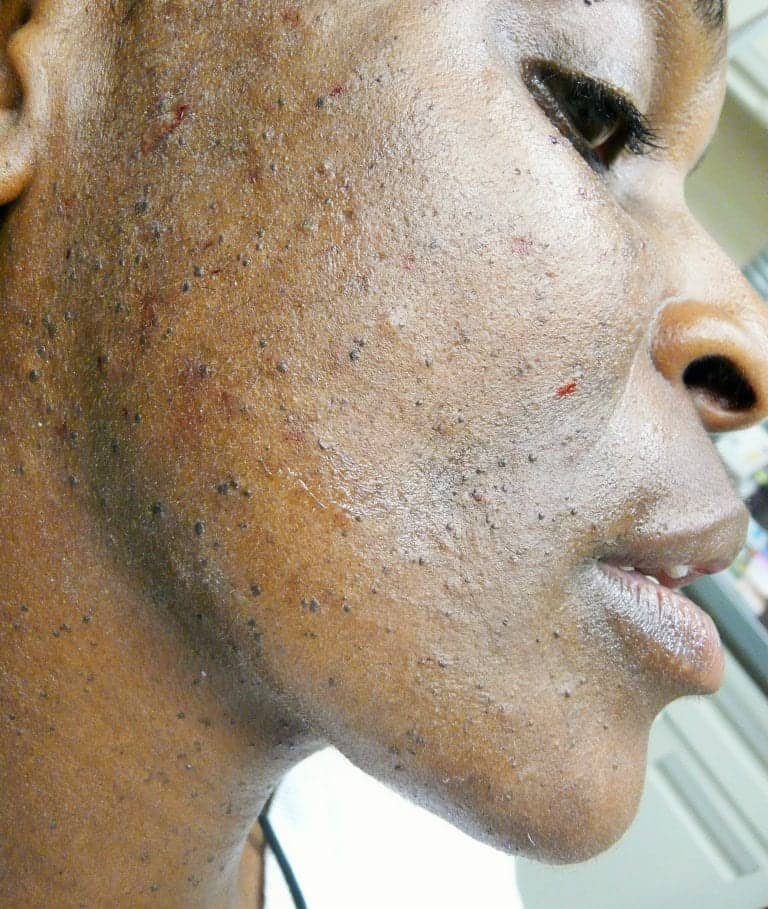What Is A Skin Tag?
A skin tag is a small, soft skin growth or outpouching of skin attached to the epidermis by a thin stalk called a peduncle. In the medical community, they are also called soft fibromas. Other terms include fibroepithelial polyps, cutaneous tags, fibroepithelial polyps, or acrochordons. These long names may sound scary, but skin tags themselves are benign. Also, they are typically flesh-colored (though sometimes darker in pigment). People often seek methods of skin tag removal with pain control simply due to their unsightly appearance or because of physical irritation. Skin tag causes are largely unknown, though there are certain factors that bear a strong correlation to their growth.
For those wondering how to remove skin tags themselves, there are many natural and over-the-counter skin tag removal products that claim to get rid of these growths. However, not every skin tag treatment will be effective; and without the chance of infection and/or scarring.
To guarantee safe, effective, and lasting skin tag removal with pain control, the best option is to have the growth removed by a dermatologist. The procedure is quick and, at Dr. U Hair & Skin Clinic, Dr. Umar takes all pain management measures to ensure comfortable skin tag treatment.
What Are the Main Skin Tag Causes?
The exact causes of skin tags remain unclear. But they are relatively common–about 25% of people will develop these growths. They can grow from a few millimeters to half an inch long and can appear anywhere on the body. You may notice just one, or several; they may be concentrated in one location or scattered in various places. Some people can develop hundreds of these tiny growths. Certain strong correlations can be linked to skin tag causes. These include:
- Skin-against-skin friction. While these outpouchings can form anywhere, they have a tendency to grow along natural folds and creases in the body, such as:
- Armpits
- Eyelids
- Neck
- Groin
- Obesity, or being overweight
- Diabetes
- Older age (most common in age 50+)
The friction of tight clothing, bra straps, underwear elastic, etc may also be among the possible skin tag causes. If you are overweight, avoidance of tight clothing may help prevent skin tags.
High Occurrences/Large Numbers of Skin Tags
A high occurrence of skin tag growths, or a large quantity of these formations, is largely linked to the increased skin friction caused by obesity. One study showed that obese subjects in a clinical trial were not only more likely to develop skin tags, but mixed-color skin tags in particular. (Some flesh-colored, and some of a darker pigment.) The occurrence of growths also increased significantly with age. The same study showed that diabetes is not linked to mixed-color skin tags.

How to Remove Skin Tags
When to See a Dermatologist for Skin Tag Removal
The optimal time to seek medical care for skin tag treatment is if you are feeling particularly strong about getting rid of your condition. In particular, you should consult a dermatologist to have them safely, painlessly, and quickly removed, if:
- You have bothersome skin tags that affect you cosmetically
- Your skin tags cause irritation with the friction of physical activity
- You have several skin tags
Non-surgical or Medical Skin Tag Treatment
There are a few options for medical skin tag treatment, all of which are quick and effective. Depending on the clinic where you receive care, and their pain management procedures, the treatment may be moderately painful. Inquire about this aspect of your treatment during your consultation.
Cryosurgery
This method of skin tag removal with pain control simply involves super-freezing the growth. It will quickly fall off and there is no downtime or aftercare needed.
Cautery
This medical method of removal destroys the skin growth by burning the tissue with extreme, targeted heat. There will be a small, thin scab as a result, which will heal naturally with no downtime or aftercare needed. Do not pick the scab.
Snip Excision
This method of skin tag treatment uses surgical scissors to simply snip the skin tag at its base. If bleeding results, Dr. Umar will cauterize the site to stop the bleeding. A small, thin scab will result, which will heal naturally with no downtime or aftercare necessary. Again, do not pick the scab.

Medical Skin Tag Removal with Pain Control at Dr. U Hair & Skin Clinic, Manhattan Beach Los Angeles
If you want skin tag removal with pain control as a priority, consult with Dr. U Hair & Skin Clinic. Dr. Umar places an emphasis on patient comfort, taking every pain management precaution. Using any of the medical skin tag treatment methods discussed above, Dr. U first applies a topical numbing cream. He then injects each skin tag with local anesthesia using a light 31-gauge needle. After this, the patient will not be able to feel the removal procedure, whether cryosurgery, cautery, or snip excision is used.
If you live in the Los Angeles area, you may schedule a complimentary consultation to discuss your skin tag condition with Dr. Umar by clicking the button below.
[dt_button link=”/skin-clinic/free-consultation/” target_blank=”false” button_alignment=”center” animation=”fadeIn” size=”big” style=”default” bg_color_style=”default” bg_hover_color_style=”default” text_color_style=”default” text_hover_color_style=”default” icon=”fa fa-chevron-circle-right” icon_align=”left”]FREE CONSULTATION[/dt_button]Frequently Asked Questions – Skin Tag Removal with Pain Control
Are At-Home Skin Tag Removal Products and Methods effective?
Many people will first search for how to remove skin tags at home, to avoid a doctor visit. Natural and DIY skin tag removal products range from home remedies like apple cider vinegar, tea tree oil, or nail polish remover, to over-the-counter serums and electronic devices. The claim is that these products will suffocate the skin tag and cause it to eventually fall off. Some of the methods further recommend tightly bandaging or tying off the skin tag once the remedy is applied. This will cut off blood supply to the growth and cause it to separate more quickly.
Another DIY option discussed online for skin tag treatment is to cut the growth off and treat the wound with any of the above natural products. However, Dr. Umar does not recommend these approaches. These at-home skin tag removal products and methods can be dangerous, painful, lengthy, and can lead to infection and scarring.
If you’re wondering when to see a dermatologist for skin tag removal, the medical recommendation is to seek consultation if you are not willing to leave them alone. When a skin tag bothers you to the point of seriously considering at-home treatment, it is time to see a medical dermatology professional.
Is medical skin tag treatment covered by health insurance?
Medical skin tag treatment is not typically covered by health insurers because it considered an elective cosmetic procedure. However, the cost to pursue skin tag removal with pain control is low for the comfort, quickness, and peace of mind. The cost can range anywhere from $150 to $300.
I asked my primary care physician how to remove skin tags and she/he said to tie it off myself with dental floss. Is this safe?
Dr. U Hair & Skin Clinic does not advise taking this approach. Some doctors may suggest that their patients attempt DIY methods, like using dental floss or a rubber band to tie off skin tags in order to remove them. However, this is not recommended, as such approaches can lead to infections and other unforeseen consequences. And because skin tags are a living part of your skin, the risk high levels of pain and bleeding may occur if removal were attempted at home. Skin tag removal should always be performed by a qualified dermatologist to ensure the safest outcomes possible.
Is it possible for skin tag causes to include cancer?
Skin tags are benign growths, meaning they are non-cancerous. These growths have not been linked to cancer. Diabetes is the only disease with a causal correlation to skin tags.
If you have more questions about skin tag removal not answered above, use the button below to submit your inquiry to Dr. Umar.
[dt_button link=”/skin-clinic/ask-dr-umar/” target_blank=”false” button_alignment=”center” animation=”fadeIn” size=”big” style=”default” bg_color_style=”default” bg_hover_color_style=”default” text_color_style=”default” text_hover_color_style=”default” icon=”fa fa-chevron-circle-right” icon_align=”left”]ASK DR. U[/dt_button]
